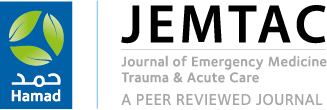- Home
- A-Z Publications
- Journal of Emergency Medicine, Trauma and Acute Care
- Previous Issues
- Volume 2020, Issue 2
Journal of Emergency Medicine, Trauma and Acute Care - Volume 2020, Issue 2
Volume 2020, Issue 2
-
Sliding Doors During COVID-19: Choose the Right One!
More LessAuthors: Tommaso Piani, Davide Zanardo and Cristian DeanaThe need to resume scheduled hospital activities requires accurate screening for severe acute respiratory syndrome–Coronavirus disease 2019 (SARS–COVID-19) represented by real-time polymerase chain reaction on the nasal swab for each patient admitted. In order to prevent cross-contamination, we propose a model in which only two entry points are available: one for the urgent/emergent pathway and the other for all patients needing Read More
-
Utilization of prehospital emergency medical services in Saudi Arabia: An urban versus rural comparison
More LessAuthors: Ahmed Ramdan M Alanazy, Stuart Wark, John Fraser and Amanda NagleBackground: There is limited research outside the USA, Europe, or Australia on the capacity, efficiency, and development of prehospital emergency medicine services (EMS) between urban and rural areas. This study aimed to examine the usage of prehospital EMS across rural and urban areas in Riyadh region in the Kingdom of Saudi Arabia. Methods: A random sample of 800 (400 urban and 400 rural) emergency patient records from Read More
-
Outcomes of out-of-hospital cardiac arrest in relation to prehospital care services in Hospital Canselor Tuanku Muhriz: A prospective study
More LessAuthors: Azizul Hafiz bin Abdul Aziz and Nik Azlan Nik MuhamadBackground: The role of prehospital care (PHC) services in out-of-hospital cardiac arrest (OHCA) is well established in developed countries. The American Heart Association has defined PHC as the ‘chain of survival’ between public and advanced medical care. For developing countries such as Malaysia, the importance of PHC services in OHCA is evolving; however, data are lacking. Objective: This study aimed to investigate OHCA outcomes in rela Read More
-
Nosocomial infection acquired during intensive care admission impacts mortality in patients admitted with deliberate self-harm
More LessObjective: Deliberate self-harm (DSH) is an important cause for intensive care admission in developing countries. The evaluation of incidence and risk factors for nosocomial infection development in DSH with its impact on the outcome is not clearly elucidated. Methods: Demographic, infection, and outcome data were collected in this retrospective study of 2 years. Factors associated with infection and mortality were explored using bivari Read More
-
A prospective cohort study of patients with peptic perforation to identify high-risk clinical characteristics
More LessAuthors: Ahmed Ziarra Khalaf, Mazin A. Abdulla and Ahmed AR IssaIntroduction: Peptic ulcer perforation is the most common complication in peptic ulcer disease and can lead to serious complications and mortality; however, despite the widespread use of antisecretory agents and eradication of Helicobacter pylori, the incidence of peptic ulcer perforation remains largely unchanged. This study aimed to evaluate the risk factors for perioperative morbidity and mortality in patients with peptic ulcer perfor Read More
-
Ultrasound-guided supracondylar radial nerve block to manage distal radius fractures in the emergency department
More LessAuthors: Mehdi Nasr Isfahani and Maryam JavidBackground: Distal radius fractures, the most prevalent of all fracture types, are often associated with severe pain and discomfort and treated with closed reduction and splinting. This study aimed to compare ultrasound-guided supracondylar radial nerve block with procedural sedation for the treatment of distal radius fractures in the emergency department. Methods: Patients with isolated distal radius fractures and limited displace Read More
-
Efforts for measles elimination in the Gulf Cooperation Council countries 2015–2019: A review
More LessAuthors: Salah T. Al Awaidy and Iyad OmerThe World Health Organization (WHO) and member countries aimed to eliminate measles by 2020. In 1997, the Regional Committee for the Eastern Mediterranean (EMR) had unanimously adopted a resolution for measles elimination reduction goals for the interruption of measles transmission in EMR countries by 2010.1,2,3 Among Gulf Cooperation Council (GCC) countries of the Eastern Mediterranean Region of WHO, Oman and Bahrain a Read More
Most Read This Month
Article
content/journals/jemtac
Journal
10
5
true
en


